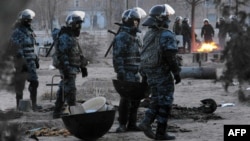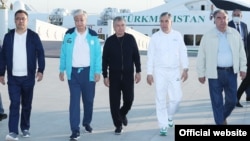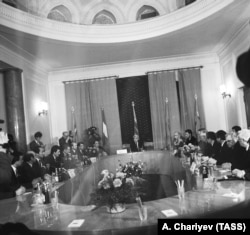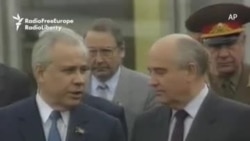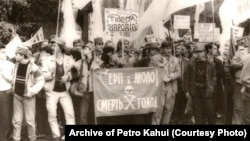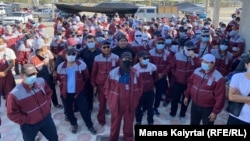
There have been several big labor strikes in Kazakhstan this summer and with the 10th anniversary of the tragic events in the city of Zhanaozen approaching, Kazakh authorities must be wondering about the potential for unrest.
Most of the strikes were in the oil-rich Mangystau Province in western Kazakhstan, but it was not only oil workers who stopped working.
Higher pay was the common demand, which included in some cases a “13th month” -- or extra month -- of wages; partial or full payment to sanatoriums for employees working in areas with toxic fumes; reimbursement for COVID-19 tests; and more milk.
But there are deeper problems that fuel these disputes, chief among them the presence of foreign workers and the perception among many Kazakh workers that these foreigners have better salaries, that local managers are compensated far better than workers, and that the workers' trade unions are constantly under pressure from Kazakh officials.
Another Strike In Zhanaozen
Some 600 employees of the KEZBI company -- which repairs and maintains oil wells -- went on strike in Zhanaozen on June 30.
It is often very hazardous work. In November 2013, 28 people from KEZBI were hospitalized after being poisoned at a work site. Two of them died.
KEZBI has been operating in Kazakhstan since 1992 and currently employs some 1,200 people, which means that half of the workforce was on strike on June 30.
Workers had warned KEZBI management on June 21 that they would stop working if their demands -- which included doubling their salaries, extra pay for working on holidays, and access to sanitoriums -- were not met.
A week later, the management partially met the workers’ demands, agreeing to raise salaries by 50 percent, give bonuses when work was completed, and providing stipends of 146,000 tenge (about $340) for employees to go to sanatoriums.
The sale of oil from Mangystau Province has helped fill state coffers, build the new Kazakh capital, Nur-Sultan (formerly Astana), and enrich a small group of people. But little of the wealth was used to improve life in western Kazakhstan.
Mangystau is mainly made up of the Kyzyl-Kum Desert, which is scorching hot in the summer and bitterly cold in winter.
The province is also one of the most expensive places to live in Kazakhstan. Almost everything needed to survive, including water, needs to be brought to the towns, many of which were built exclusively for oil industry workers.
Related Firms United With Oil Workers
Wages for many are insufficient to meet the rising cost of basic goods, so it was predictable that labor strikes would break out somewhere.
But it was perhaps less predictable that workers from so many different companies would follow the lead of this summer’s early strikes.
Workers in Zhanaozen at the Oilfield equipment and service company and at Aqtau Oil Service Company announced they were on strike on July 21 and wanted higher pay and food to be made available at the work sites.
One week later, in the town of Karazhanbas, 174 workers at Industrial Service Resources, which assembles equipment and does repairs at oil wells, declared they were on strike until their wages were doubled, they received a 13th month of pay, and that no more pressure would be put on their trade union.
More than 30 of the 150 workers at Zhanaozen-based Batysgeofizservice, a company providing geophysical research for oil wells, announced they were on strike on July 19, demanding a 50 percent increase in pay and 30 vacation days per year.
Several transportation companies working for oil companies also went on strike, including some 130 workers at Munayspetssnabkompani, which transports goods for Ozenmunaygaz and Ozenmunayservis, who stopped working on July 15. They demanded that their pay be doubled, as their monthly salaries of some 110,000 tenge (about $258) were too low.
Some drivers said management had already threatened to fire them and find replacements if they did not return to work.
About 200 drivers at Kunan Holding went on strike on July 19, demanding their wages be doubled, despite management having agreed to give them a 20 percent raise on July 15.
Workers at KMG-Security also went on strike on July 13. The firm provides security at oil fields in Mangystau belonging to Ozenmunaygaz.
Workers said new employees receive 57,000 to 60,000 tenge (about $130 to $137) per month, and that even people with 20 years of experience were only being paid 80,000 tenge (about $187).
KMG-Security personnel demanded that their pay be increased to 150,000 tenge (about $351) monthly.
The security workers at Karazhanbas announced their support for the KMG-Security workers on July 16 and ceased working, saying their salaries were barely enough to make ends meet. They also wanted their monthly wages raised to 150,000 tenge ($351).
Food services also joined in the series of strikes.
In Zhanaozen, dozens of workers at Caspian Catering Service went on strike on July 27, followed by workers at KMG EP Catering three days later.
Female employees at the Caspian food catering service in Karazhanbas stopped working on August 4, demanding monthly wages be increased to 220,000 tenge (about $515).
Lenin's Milk
Workers at NBKS, a company that provides cleaning and janitorial services at Ozenmunaygaz facilities, went on strike on July 21, calling for their salaries to be doubled, extra pay for working on holidays, extra money to go to health sanitoriums, special benefits for mothers who were working there, hot meals to be included when they work, and for milk to be provided to them.
According to Kazakh law, at least half a liter of milk must be provided daily to workers in sectors where they are exposed to toxic chemicals, poisonous fumes, or radiation.
That practice dates back to Soviet founder Vladimir Lenin, who issued a decree in 1918 that employers must provide milk for workers at the Putilov machine and metallurgy plant (later renamed the Kirov plant) to prevent workers from going hungry. It was later expanded to include workers in hazardous industries, such as the oil sector.
Other Industries Join
There were also numerous strikes outside the oil industry and its support companies.
Forty-five ambulance drivers in Zhanaozen went on strike on July 15 demanding their wages be doubled.
Workers at Tazalyk-S in Zhanaozen announced they were on strike on July 19. The company is responsible for cleaning Zhanaozen’s streets and public areas.
Workers wanted their salaries doubled and regular provision of essential items for their work -- special equipment, gloves, soap, and more milk. The workers said they had been making these same demands since 2020.
Workers at Ozenenergoservis said on July 25 they refused to work unless their salaries were doubled. Ozenenergoservis provides power to Zhanaozen. The workers threatened to cut electricity to the whole town, except hospitals, maternity hospitals, and essential facilities in the town, if their demands were not met.
And the strikes were not only in Mangystau Province.
On July 12, workers from Almatymetrokurylys, the company building the Almaty subway, refused to go to work until their salaries -- which they said were between 50,000 to 90,000 tenge -- were doubled, they received a 13th month of pay, and they received their milk.
Bus drivers in Aqtobe went on strike on August 19, demanding the payment of wage arrears. The company made the payments on August 21 and the bus drivers returned to work.
Nearly all the strikes were eventually resolved, though not all.
At least three labor strikes were still ongoing as of early September, the longest a strike at the Zhetibay site in Mangystau Province by some 500 employees of West Oil Software, who stopped working on August 23.
As a recent report from The Diplomat noted, there were more labor strikes in Kazakhstan in the first six months of 2021 than there were combined for the period 2018-2020.
December 16 will mark the 10th anniversary of the day police opened fire on protesting oil workers in Zhanaozen. At least 16 people were killed.
Then, as now, Ozenmunaygaz was at the center of the labor problems.
Kazakhstan had never seen anything like it in all its years of independence. Perhaps Zhanaozen is why companies have been more receptive to the demands of workers, who usually don’t get all they want but do have some of their demands met.
An exchange of words during the KEZBI strike shows how tense the situation can get.
One of that company's striking workers recounted to RFE/RL’s Kazakh Service, known locally as Azattyq, that deputies from the provincial "maslikhat" or council, came to speak with the strikers on July 4. The deputies were from the Ak Zhol party and the ruling Nur-Otan party.
One of them, Maksat Makishev, addressed the workers by saying: “We are deputies who you elected.” To which the striking workers replied, “You were named to your posts; the people did not elect you.”
The partial success of this unprecedented number of strikes in Kazakhstan guarantees that more will be coming, while companies are claiming to striking workers that their finances are often beyond their control as they await the results of tenders or the approval of new state budgets.
It definitely looks like workers and management in the many companies that make up Mangystau’s oil industry are once again on a collision course.




